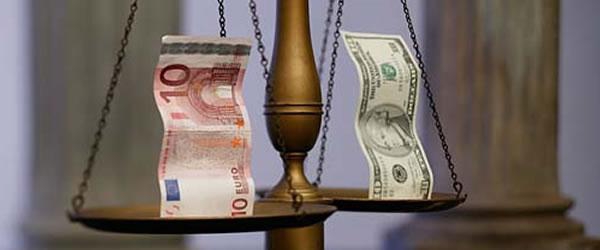After reading this article, you will learn what the foreign exchange market and the exchange rate are. We will consider these concepts in detail, give their classifications and give examples.
The foreign exchange market is a sphere of economic relations that appear when performing sales operations or when purchasing securities in foreign currency (or the foreign currency itself), as well as related to the investment of foreign currency capital. This is the official financial center in which the sale and purchase of all of the above are concentrated on the basis of supply and demand for it.

Functional, institutional and organizational-technical features of foreign exchange markets
In terms of functionality, foreign exchange markets today provide for the implementation of various international settlements, as well as insurance against risks associated with foreign currency, diversification of foreign exchange reserves, profit-making by participants due to differences in exchange rates, and foreign exchange intervention. From an institutional point of view, they are a combination of investment companies, authorized banks, brokerage houses, various exchanges, as well as foreign banks that carry out foreign exchange transactions. From the point of view of organizational and technical, the foreign exchange market is a set of communication systems connecting banks of different countries that carry out international payments and other foreign exchange transactions.
Participants in the foreign exchange market on and off the exchange
The entities participating in the exchange are entrepreneurs, brokers, dealers and players. There are also entities outside the currency exchange. These are the participants of the foreign exchange market, such as:
- brokerage office;
- authorized bank of the Russian Federation;
- citizen;
- business entity;
- investment company;
- foreign bank.
Exchange rate
The national currency in the foreign exchange market is exchanged for money of other states. The exchange rate is a proportion, a quantitative ratio in which the currency of a certain state is exchanged for the monetary unit of a country. In other words, this is the price of a unit of foreign currency, expressed in a number of national currency units. It is this rate that determines the situation in the foreign exchange market. When the price of a unit of foreign currency in terms of domestic increases, depreciation of the domestic one occurs, and vice versa.
Types of Exchange Rates

The following types are distinguished:
- fixed - officially established ratio between the currencies of certain states, based on mutual parity;
- fluctuating - the exchange rate that changes freely under the influence of supply and demand;
- floating - a kind of oscillating, involving the use of the mechanism of currency regulation.
In 1976, at the Jamaican Conference, it was decided to introduce a floating rate system. The state, as a rule, imposes a certain restriction on the export, import and transfer of foreign and national currency abroad and from abroad. The ratio of supply and demand determines all prices of a market economy, as well as currency prices (that is, exchange rates).
What determines the supply and demand in the currency market?
The following factors determine the size of supply and demand in the foreign exchange market:
- on the volume of trade between states (for example, the demand for the brand is greater, the greater the trade exchange between the country and Germany);
- on the state of the state economy and the extent of inflation;
- from the purchasing power of national currencies.
The latter is determined by the number of identical services and goods that can be purchased for a certain amount of different national currencies (in other words, a consumer basket). For example, for 100 rubles, francs, dollars, etc.
Consumer basket
However, the ratio of currencies in different countries in terms of purchasing power for different products is not the same. In world practice, therefore, today the exchange rate can be determined based on purchasing power parity. It acts as a result of comparing the amount of goods that can be bought on the markets of different countries in national currency. In this case, the same set of goods is taken to the basket and the necessary amount is determined for the purchase of this set in different countries.
Only by using many different services and goods that are included in the consumer basket of the two states can objectivity of comparison be achieved. For example, if in Russia a basket will cost 815 rubles, and in the United States - $ 100, then the exchange rate (the price of one dollar) will be 8 rubles. 15 cop., 19 cents will be the price of one ruble. Therefore, if prices double in our country, and in the USA they remain unchanged, then the dollar / ruble exchange rate, if other exchange conditions remain the same, will increase by 2 times. But in reality, the exchange rate can deviate significantly under the influence of many reasons. For example, the exchange rate may increase due to the demand for foreign currency.
However, the greatest difficulty is that there is no single way to determine the composition of the consumer basket. The structure of consumption of goods and services included in it varies from country to country. However, there is no other way to determine the exchange rate.
Currency Market Classifications
Currency markets can be classified according to many criteria: in relation to various currency restrictions, in terms of distribution, by degree of organization and types of currency resources.
The breadth of coverage, that is, in terms of distribution, distinguish domestic and international currency markets. Both the one and the other, in turn, consist of regional ones formed by financial centers in the regions of a given country or the world (for example, the Moscow currency market).
International and domestic currency markets

International unites the currency markets of all countries of the world. It means a chain of global regional markets connected by a satellite and cable communications system. Between them there is an overflow of funds under the influence of current information, as well as forecasts about the possible position of certain currencies that are made by leading market participants.
The domestic foreign exchange market is the market of one state, that is, functioning within a country. It consists of regional domestic markets, which include foreign exchange whose centers are located on interbank exchanges.
Free and non-free markets

One can also distinguish non-free and free foreign exchange markets in relation to one or another currency restrictions.
The latter are a system of state measures (administrative, organizational, economic, legislative) to establish the procedure for operations with various currency values. They include measures aimed at targeted regulation of payments, as well as transfers abroad of foreign and national currencies. The currency and financial market, in which there are currency restrictions, is not free, and in their absence - free.
Single and dual mode markets
The market for the types of exchange rates that are used on it can be double or single mode. With one mode - when free exchange rates exist, that is, exchange rates are floating, their quotation is set at the exchanges during trading. For example, the official ruble rate is set thanks to fixing.
Fixation
Fixing in Russia is carried out by the Central Bank of the Russian Federation on the Moscow Exchange. It represents the definition of the US dollar against the ruble. The fixing rate in this way is a single rate of the Central Bank in the currency market of the Russian Federation. Using the information of the Reuters agency on cross rates, he displays through it the ruble exchange rate with respect to other currencies. Twice a week, currency fixing occurs. The Central Bank of the Russian Federation on the day it reports the rates of major freely convertible currencies against the ruble by publication in the media.
Dual mode
A dual-mode market is one in which a floating and fixed exchange rate is applied. An example of this is the currency market of the Russian Federation. The introduction of such a regime is used by countries as a measure aimed at regulating the movement of capital in the international and national market for loan capital. This measure is designed to control and limit the impact on the economy of this country of the international market for loan capital. In our country, for example, Vnesheconombank, in relation to blocked accounts for foreign investments (in case settlements are not fully completed), applies the ruble exchange rate, which is the commercial rate set by the Central Bank of the Russian Federation.
OTC and Exchange Markets
According to the degree of organization, there is an over-the-counter and an exchange currency market (of the Moscow Exchange, for example). Exchange - an organized market represented by a currency exchange, that is, an enterprise that organizes trading in foreign currency and securities in it. The exchange is not a commercial enterprise. Its main function is not in generating profit, but in mobilizing funds that are temporarily free through the sale of currency and securities in it, and in establishing the exchange rate, that is, its market value. In our country, for example, the largest is the currency market of the Moscow Exchange. It was created in 2011 through the merger of the MICEX and the RTS.
The exchange currency market has a number of advantages. It is the cheapest source of foreign currency and currency; bids placed have absolute liquidity. What is the liquidity of securities and currencies? It means their ability to quickly turn into a national currency without loss in value.
The over-the-counter currency market is organized by various dealers. They may or may not be members of the currency exchange and conduct their activities through computer networks, fax, telephone.

Over-the-counter and exchange-based foreign exchange markets, the development of which takes place in parallel, to some extent contradict each other. At the same time they are complementary. This is due to the fact that, in carrying out their activities, the general function of the circulation of securities and currency trading, they use various forms and methods of selling currency and securities in it.
The advantages of the over-the-counter currency market are as follows. Firstly, at a fairly low cost associated with currency exchange operations costs. Often, bank dealers use face-to-face currency auctions to reduce their costs of currency conversion, concluding sale and purchase contracts at the exchange rate set before bidding. Commissions are withdrawn from bidders on the exchange, and their amount directly depends on the amount of ruble and currency resources that they managed to sell. The law, in addition, establishes a special tax on transactions on the exchange. The currency conversion operation in the OTC market is carried out for an authorized bank after finding the counterparty to the transaction practically free of charge.
Secondly, here the calculation speed is higher than when trading on the exchange. This is mainly due to the fact that the over-the-counter currency market allows transactions to be carried out during the trading day at any time, and not just at a specific time of the exchange session. Therefore, the OTC currency market is very important.Each state needs its development for faster and less costly currency exchange.
OTC market in terms of trade significantly exceeds the stock market. The most liquid in the world today is considered the OTC Forex market. It operates around the clock in all world financial centers (from Tokyo to New York).
Other types of foreign exchange markets

In classifying the markets, the foreign exchange markets for Eurobonds, Eurocurrencies, Eurocredits, Europosites, “gray” and “black” markets should also be highlighted.
The Eurocurrency market is an international market for Western European currencies, where operations are carried out in the currencies of these states. Its functioning is due to the fact that currencies are used in non-cash non-cash deposit and loan operations outside the emitent states. In the Eurobond market, financial relations in Eurocurrencies for debt obligations occur in the case of long-term loans executed as bonds of borrowers.
In the euro-deposit market, financial relations are carried out on deposits of commercial banks of various countries in foreign currency at the expense of funds that are circulated in the euro-currency market. Accordingly, in the Eurocredit market there are stable financial relations and credit relations for the provision of various international loans by commercial banks in foreign currency.
Central Bank Interventions

Interventions in the foreign exchange market are carried out by the Central Bank of certain countries to manipulate the exchange rate of these states. Sometimes they are organized in several Central Banks. For example, the interventions of the Bank of Japan, the Fed and the ECB led to the fact that in 2011 the price of the yen fell by 2%. This was done in order to support Japan after a major earthquake. The economy of this country was supported by a decrease in the yen against the dollar.
In addition to changing the quotes of certain currencies, interventions are also used to control the state over the volatility of the currency market, manage liquidity, increase the reserves of the Central Bank (in different currencies), and stimulate the outflow and inflow of capital. Interventions are often carried out in the short term. They are fictitious and real. The Central Bank during real interventions really makes a stuffing or buying up the currency. With fictitious ones, he only declares his intention to carry out certain monetary operations. Fictitious interventions are also aimed at changing currency quotes although they have very short-term consequences.
Now you know what the foreign exchange market and the exchange rate are. These topics are very important in the international economy, especially today, when exchange rates are rapidly changing.








